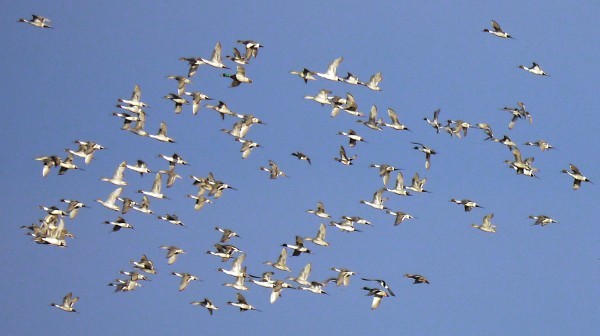Above: This wintering pair of Northern Pintails had to contend with an unusually persistent snowfall at the George C. Reifel Migratory Bird Sanctuary near Vancouver; photo by Peter Taylor.
How do I recognize it?
The Northern Pintail is a dabbling duck, slightly smaller and distinctly slenderer than a Mallard. The breeding-plumage male, as seen from winter to early summer, is unmistakable with its chocolate-brown head, much white on its long neck, a finely marked grey body, and long central tail feathers for which it is named. Females, non-breeding males, and juveniles are slightly paler and slimmer than female Mallard. Fine points include a grey bill and lack of strong facial markings.
Does it migrate?
North American pintail populations breed across much of Canada and the northwestern United States (including Alaska). They migrate to spend the winter in relatively mild regions of North America, southward to parts of Central America. Eurasian breeding populations migrate similar distances to mild and subtropical climes.
Above: This male Northern Pintail, showing off its field marks while preening, was wintering at a small park near the centre of Tokyo, Japan; photo by Peter Taylor.
Where does it live?
In Canada, Northern Pintails breed mainly in prairie and Arctic wetlands. They generally avoid mountainous and densely forested regions.
Above: Northern Pintails are well adapted to feeding in shallow water; photo by Peter Taylor.
Where can I see it?
Pintails are early spring migrants, many of them arriving in southern Manitoba with the first Mallard flocks in late March to feed at sheet water in stubble fields. Spring flocks often number in the thousands. They can usually be seen from then to early fall at major wetlands such as Oak Hammock Marsh and Whitewater Lake, as well as smaller prairie potholes, tundra ponds near Churchill, and (when accessible) at sewage lagoons.

Above: A spring flock of ducks, mostly Northern Pintails, over flooded stubble near Stead, Manitoba; photo by Peter Taylor.
Conservation Status
Though not endangered, and still numbering in the millions, the Northern Pintail has suffered the most dramatic decline of all North American dabbling ducks over the past half-century – a matter of great concern for waterfowl managers. This calls for close cooperation among wetland, cropland, and rangeland managers to improve nesting success.
Did you know?
In drought years on the prairies, many Northern Pintails “overshoot” to Arctic breeding grounds, sometimes traveling as far as eastern Siberia. In more favourable years, a larger proportion will hold back to breed at prairie potholes.
Above: An unusually late fall bird, this juvenile male Northern Pintail was at Gull Lake, Manitoba just before freeze-up in late October 2020; photo by Peter Taylor.

